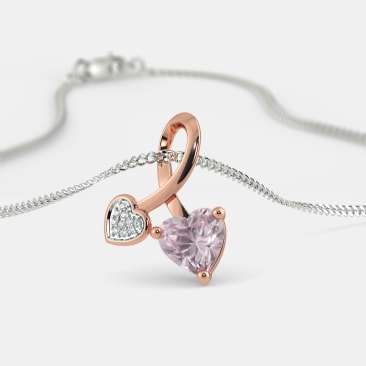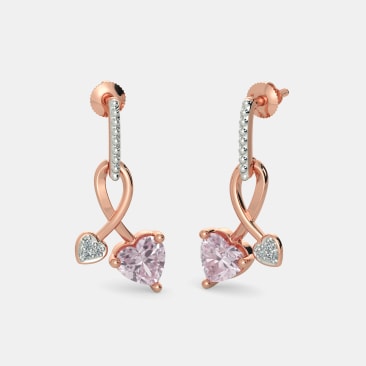Quartz
Do you think it’s hard, if not impossible, to find a gemstone that is beautiful, sparkling, durable, colourful, and budget-friendly at the same time? Well, it’s about time you think again. It’s about time you think quartz!
This semi-precious stone is not as expensive, rare, or valuable as your rubies and diamonds. But it is in the good book of every ardent jewellery lover.
But why? And what makes them popular? Why does the charm of quartz rings, earrings, pendants, and necklaces never cease to fascinate people?
Here is everything you should know about quartz – an overview of the stone, its history, different types, and instructions for buying as well as caring.
Overview
Let’s get the basics first!
Quartz is a mineral with a chemical composition of silicon and oxygen. It is attractive, hard and durable. Though some types of quartz crystals are rarer than others, they are all available in a large variety of sizes. It is no wonder, therefore, that they are often used for making statement jewellery. It is a versatile gem that can be cut in a number of ways. With a value of 7 on the Mohs scale, the stone is quite hard but may be prone to scratches.
And, do you know that India, along with Brazil, Madagascar, and the US, is one of the largest producers of this semi-precious stone?
And the best part is yet to come.
Unlike diamonds, quartz is found easily. In fact, this is the second most abundantly available mineral on the earth. It is available in a number of different colours and different varieties of the stone are called by different names. So when you want to sport a dash of colours without having to spend too much, you know which stone to choose, don’t you?
History of Quartz
Every gemstone has a history. So has quartz.
The term quartz is believed to have been generated from the German word ‘quarz’. This, in turn, has its origins in Polish and Slavic terms and means hard. This is probably because this stone is often used to classify stones as hard or soft. According to another story, the name is derived from the Greek word, kruos which means icy cold.
Can you guess why?
Many Greek philosophers believed that quartz was a form of super-cooled ice. Take a look at some pictures of this stone and you will know why they cannot be blamed for thinking so. Evidence of the use of this gem goes back to the prehistoric era when it was used to make tools. It is also often found in European tombs belonging to the middle ages.
Types of Quartz
Pure quartz, which is also known as rock crystal, is colourless and transparent in nature. However, this stone is available in a wide range of colours as a result of impurities in it. Here are some of its popular varieties.
Amethyst: Quartz with traces of iron has a purplish hue and is known as amethyst. This is the most valuable form of this crystal.
Citrine: Have you ever been captivated by the refreshingly yellow colour of the citrine stone? Surprise, surprise! Citrine is also a variety of quartz and its colour varies from pale yellow to a brownish red. The former is rarer than the latter.
Smoky quartz: What’s the most uncommon yet extremely charming colour you can find a gemstone in? The answer is, yes, black! Smoky quartz, another member of the quartz family, is a celebration of the colour black. You can also find this stone in grey and brownish-grey colours. It is important to note that no matter how dark the colour of this stone may be, it is rarely opaque. Smoky quartz earrings, rings, and pendants have a unique charm and hence are extremely popular among jewellery lovers.
Rose quartz: Rose quartz has a milky appearance with a colour that ranges from light and medium pink to rose-red hues. Gold necklaces, earrings, rings, and pendants studded rose quartz make the perfect gift you can choose for a loved one.
That’s not all!
Ametrine appears as a blend between amethyst and citrine. It has multiple colour zones with both purple and yellow shades. Rarer varieties of quartz, such as blue quartz and Prasiolite are also available in the market today.
Birthstones and Anniversary Stones
Different types of this stone are considered the birthstones for different months. Amethyst is the birthstone for February. Citrine is the birthstone for people born in November. Similarly, rose quartz is considered the birthstone for Taurians while rock crystal is the one for Leos. Amethyst is gifted on the sixth and ninth wedding anniversary of a couple. Likewise, citrine symbolises 11 or 13 years of a happy marriage.
How to Tell Real Quartz Apart from Fake Quartz?
Even though this semi-precious is available abundantly, glass or other crystals are often sold in place of quartz. For example, purple fluorite may be sold as amethyst. Amethyst may also be treated with heat to change its colour. This may be then sold as citrines.
But worry not! There are simple ways to identify real and fake ones.
Heat-treated quartz can be identified as having dark tips and a white base. Another telltale sign to look for in cases of dyed crystals is an accumulation of colour in the cracks. Glass may also be used as a substitute for quartz. To tell them apart, you need to look for bubbles inside the stone. These are usually present in glass but are never seen in quartz crystals. Glass will also be more susceptible to scratches as compared to a real gemstone.
How to Buy Quartz Jewellery?
Quartz is inexpensive as compared to other gemstones and hence is very popular. It is also available in a wide range of colours and sizes that increases its versatility. To determine the value of this gemstone, you need to keep its colour, clarity and cut in mind. Unlike other gemstones, carat does not play a large role here. This is because these stones are readily available in small and large sizes.
Colour: The stone is available in all colours of the spectrum. However, clear stones are the most common followed by cloudy quartz. Other popular colours include purple, pink, brown, grey and black. Some varieties of quartz also appear multi-coloured in some types of light. When it comes to colour and quartz, the deeper the colour, the more valuable it is.
Clarity: Quartz crystals may be transparent or translucent. Transparent crystals allow light to pass through unhindered while translucent crystals have a cloudy appearance. The highest quality quartz crystals have no inclusions and have a bright lustre. Given the availability, there is no reason why you should buy inferior quartz. The only reason to buy a stone with inclusions unless it adds character to the stone, such as ones with the cat’s eye effect.
Cut: The colours of a quartz crystal are roughly distributed, so it is usually given a round cut to maximise the colour. Other cuts may also be used when the colour is more evenly distributed. Large quartz crystals can also be cut in fancy shapes.
How to Look After Your Quartz Jewellery?
Jewellery made of these beautiful stones can last a lifetime if handled properly. What you need to be careful about are scratches. Here are a few tips on how to store and handle your quartz jewellery.
- Do not keep your quartz bangles, pendants, and earrings with other ornaments, especially ones with harder gems. Invest in a fabric-lined box with individual pockets.
- Do not wear quartz jewellery while cooking, cleaning or doing any sort of manual work.
- A piece of jewellery can shine only when it is clean. The best way to clean quartz is to soak it in warm water and soap for a few minutes. You can then remove embedded dirt with a soft bristled tooth brush.
- Do not use steam cleaners or ultrasonic cleaners.
Now you know everything about quartz, so why not add it to your jewellery collection? Next time when you shop for a piece of jewellery, give expensive rubies or emeralds a miss. Instead, choose a rose quartz ring or a citrine pendant.




